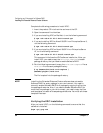
Configuring your Environment for Software RAID
Using Persistent Device Names
Chapter 3 71
Using Persistent Device Names
When there is a disk related failure and subsequent reboot, there is a
possibility that the devices are renamed. Linux names disks in the order
they are found. The device that was /dev/sdf may be renamed to
/dev/sde if any “lower” device is failed or removed. As a result, you
cannot activate the MD device with the original name.
HP requires that the device names be persistent to avoid reorientation
after a failure and reboot. For more information on creating persistent
device names, see the Using udev to Simplify HP Serviceguard for Linux
Configuration white paper that is available at the following location:
http://docs.hp.com
When creating persistent device names, ensure that the same udev rules
file exists in all the nodes. This is necessary for the symlinks to appear
and point to the correct device. Use these persistent device names
wherever there is a need to specify the devices for extended cluster
configuration or during recovery process after a failure. A persistent
device created based on the instructions in the document mentioned
earlier will have a device name that starts with /dev/hpdev/.
NOTE The name of the MD device must be unique across all packages in the
cluster. Also, the names of each of their component udev devices must
also be unique across all nodes in the cluster.


















